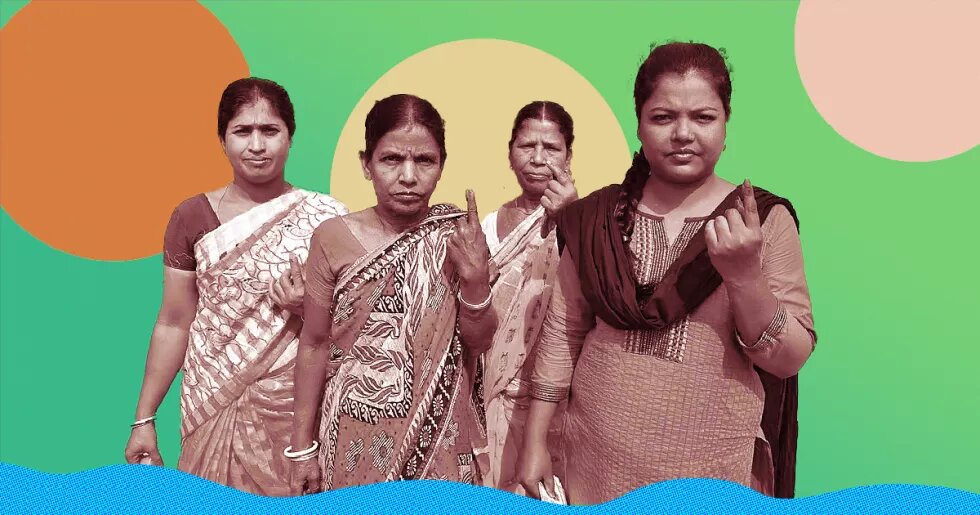Given the steep rise in their participation in elections, women have become a sought after constituency for those running for power.

As the Indian general election approaches, there is a renewed focus on the gender question in Indian politics. The Bharatiya Janata Party (BJP), the party in power at the Centre since 2014, has reiterated its commitment to India’s women voters and their welfare. Prime Minister Narendra Modi, in a special address to women workers of the party on 6 March in West Bengal’s Barasat, congratulated them on their organisational skills and stated that the support of the country’s women was his defence against the opposition parties and their attacks on him.
This extolment of women power – or what the BJP calls ‘nari shakti’ – is a part of the continued focus of the party on its women supporters. This focus rests on empirical evidence of women’s increasing support to the party as a bloc. Voter surveys by Lokniti-CSDS (Centre for the Study of Developing Societies) show that women voters preferred the BJP over other national parties in the last general elections – a shift from the earlier preferred support by women for the Indian National Congress (INC)[i]. Even in state assembly elections recently concluded in Chhattisgarh, Madhya Pradesh and Rajasthan as well as previous state elections in 2022, exit poll surveys captured an explicit support from women voters for the BJP, comparatively higher than that of men voters for the party.[ii]
Strategic focus on women voters
This support from women voters has prompted the party to focus on issues such as piped water access, free ration for the poor, sanitation, specialised fixed deposit schemes for women account holders, providing interest free loans for refilling and purchasing gas stoves for rural kitchens (Pradhan Mantri Ujjwala Yojana), and a housing scheme (Pradhan Mantri Awas Yojana) for the extremely deprived, where 70 per cent allotees are women who own the houses either on their own or jointly with their husbands. On 7 March, a day before the International Women’s Day, the Prime Minister announced a Rs.100 (1.1 euro) cut in the price of LPG[iii] cylinders for households covered under PMUY to “ease the financial burden” on women.[iv] Many of these schemes have been especially directed towards women from extremely marginal backgrounds and backward castes.
This perceived push for capturing the women’s vote however is predicated on the potential fallout of rising inflation and economic distress that has affected households across the country, and the fear of anti-incumbency sentiment as the election approaches. The courting of women’s vote as a bloc is not confined to the BJP alone; regional parties have also made a competitive push for women’s interests as their electoral strategy. Women voters have been considered influential in supporting West Bengal chief minister Mamata Banerjee and in helping her party, the All India Trinamool Congress (TMC), return to power for a third term in 2021. The INC also promised women heads of households a cash transfer of Rs.2,000 (22 euros) and free bus rides in its election promise in the Karnataka election in 2023. In Bihar, the Janata Dal (United) gained significant support from women voters for their 2016 campaign for liquor prohibition, where women voters surpassed men in election turnout and were instrumental in ensuring their election success. These overtures make strategic sense given that women voters are predicted to surpass men voters again in 2024, and their support may increase further for Modi’s party – as per a survey by the polling agency C Voter, 46 per cent of women are projected to support the ruling alliance of National Democratic Alliance compared to 43 per cent of men.[v]
Capped aspirations: Women and political parties
The increasing participation by women in polls and the active competition between political parties for their support may seem overstated given the lack of substantial representation in the legislature and executive positions. While there is clear evidence of involvement by women as voters, their political representation in the country has seen only very gradual progress. Currently women’s representation in the Lok Sabha is 14 per cent, the highest since Independence. National parties have generally paused at an unstated glass ceiling for women in elections, with nomination rates of women candidates in both the INC and the BJP ranging between 10 to 13 per cent in the last two decades for general elections. State level parties have more uneven trends, with the average women representatives in state legislatures being 9 per cent. No state legislature has more than 20 per cent women lawmakers, although regional parties such as the TMC and Biju Janata Dal (BJD) have taken a lead in nominating more women for both national and state elections in recent years.
Overall, the number of women candidates remains low; in the 2019 general elections only 9 per cent of the candidates were women, while it was 8 per cent in the 2014 general election. Many of these are independent candidates, who risk running for election despite almost no chance of winning their seats. A significant trend noted by researchers is that the rate of women independent candidates (or non-party affiliated candidates) has increased at a faster rate than the overall number of independent candidates.[vi] It shows that there is a pronounced and growing interest in women to stand for elections, but without active support of parties it remains as untapped potential. Academic research also notes that many of the women who are nominated by parties tend to be experienced women politicians, who have higher winning ratios compared to men, which means that parties tend to be risk averse when it comes to women candidates and choose those women who are more likely to succeed instead of promoting emerging women candidates.[vii] This remains the case despite both the major national parties, INC and BJP, having constituted provisions in their party constitutions to ensure 33 per cent reservations for women in party posts, as office bearers and even in executive committees. For women party members who have spent decades in organisational posts and as dedicated party cadres, this has not translated into higher nomination rates in the candidate selection process, which indicates that the pathway of politics is not linear and Indian parties need to do more for women’s representation.
Passing of the Women’s Reservation Bill
In this context, the enactment of the Women’s Reservation Bill (or the 128th Amendment Bill) in 2023, titled “Nari Shakti Vandan Adhiniyam” by the BJP will ensure 33 per cent reservation for women in Parliament as well as state legislatures. The passage of the Bill after several attempts – after it was first introduced in 1996 – has been a long-awaited demand from women’s groups. However, the timeline of its implementation is currently unclear as it will be implemented after a delimitation process based on a new national census.[viii]
In the South Asian region, India is lagging behind other regional counterparts, such as Nepal, Pakistan and Bangladesh in having a critical number of women in politics and the new Act seeks to rectify this gap. So far, the BJP has nominated candidates to 422 seats – out of which 68 are women, which is nearly 16 per cent. There are reports that the BJP will nominate a higher proportion of women this time, with regional parties such as the Samajwadi Party (SP) also claiming they will reserve 20 seats for women.[ix] As the 2024 election pitch rises, it remains to be seen if parties will follow the spirit of the new Act with concrete steps and higher nomination for women, which matches their rhetoric on the issue.
Endnotes
[i]See - Ranjan, A. 2019. How 'naari shakti' propelled PM Narendra Modi to power. India Today. Available at: https://www.indiatoday.in/elections/lok-sabha-2019/story/election-results-2019-narendra-modi-1533350-2019-05-23 and Bansal, S. 2019. How India voted in the 2019 election? India Today. Available at: https://www.indiatoday.in/diu/story/how-india-voted-2019-lok-sabha-election-india-today-axis-my-india-poll-1539617-2019-05-31.
[ii] For example, see Mishra, J. and Kumari, S. 2023. How much did women contribute to BJP’s success in Madhya Pradesh?. The Hindu. Available at:
[iii]Liquid petroleum gas used in households across India.
[iv] News Desk. 2024. PM Modi Announces LPG Cylinder Price Cut by Rs 100. News 18. Available at: https://www.news18.com/india/in-a-push-to-nari-shakti-pm-modi-announces-lpg-cylinder-price-cut-by-rs-100-8807572.html.
[v]Acharya, S. 2024. With handouts, piped water and cooking gas, India's Modi woos women voters. Reuters. Available at: https://www.reuters.com/world/india/with-handouts-piped-water-cooking-gas-indias-modi-woos-women-voters-2024-02-28/.
[vi]Ravi, S. and Sandhu, R. 2014. Working Paper: Women in party politics. Brookings Institution. Available at: https://www.brookings.edu/articles/working-paper-women-in-party-politics/.
[vii]Spary, C. 2014. Women candidates and party nomination trends in India – evidence from the 2009 general election. Commonwealth and Comparative Politics, p. 109-138. Available at: https://doi.org/10.1080/14662043.2013.867691.
[viii] Singh, R. 2023. Women’s Reservation Act and its Unsettled Details. The India Forum. Available at: https://www.theindiaforum.in/gender/womens-reservation-act-and-its-unsettled-details.
[ix]Seth, M. 2023. Akhilesh forces hands of rivals with vow to keep 20% tickets for women. The Indian Express. Available at: https://indianexpress.com/article/political-pulse/akhilesh-yadav-vow-women-tickets-samajwadi-party-8962758/.
Disclaimer:
This article was prepared with the support of the Heinrich Böll Stiftung. The views and analysis contained in the publication are those of the author and do not necessarily represent the views of the foundation. Heinrich Böll Stiftung will be excluded from any liability claims against copyright breaches, graphics, photographs/images, sound document and texts used in this publication. The author is solely responsible for the correctness, completeness and for the quality of information provided.


